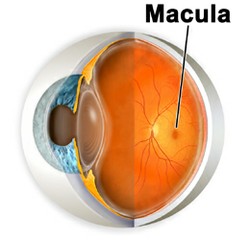One form of Age-related Macular Degeneration (AMD) is the neovascular or wet Macular Degeneration. While neovascular AMD may only occur in 10 – 20% of AMD patients, approximately 75% of AMD related vision loss is linked to this form of AMD.

Treatment Options For Wet Macular Degeneration
by CRfan
Treatment for Wet AMD has evolved significantly from using lasers to burn the retina to using injections to stem the leaky blood vessel growth.
Leaky Blood Vessel Growth
The retina has tiny blood vessels that are different to the others in the body. When the retina emits signals that it needs oxygen, as in cases of AMD, these blood vessels responsively grow. Vascular Endothelial Growth Factor (VEGF), which brings about more smaller and leaky blood vessels in the retina, is another factor that compounds Macular Degeneration. These new blood vessels are very harmful and further damage the retina. In previous years, laser therapy was the mode of treatment for AMD. Specialists would apply the laser to parts of the retina so that the remaining sight could be saved. However, the new treatments for AMD obstruct the VEGF thus preventing the eye from the growth of those damaging vessels.
Laser Photocoagulation
The first form of treatment for AMD came about in the 1970’s and a ‘hot’ laser was used to burn the retina with an emphasis on stopping the growth of the problem blood vessels. However, it was soon realized that the laser photocoagulation did not do much for patients to improve their vision. Typically, in five years, a patient who had the treatment would on average lose five lines of vision. An untreated patient after the same period would on average lose seven lines of vision. There was no assurance that new blood vessels would not grow and unfortunately, recurrence was a possibility after the first six to twelve months of treatment.
Photodynamic Therapy (PDT)
Another form of laser treatment is Photodynamic Therapy (PDT) and it targets the blood vessels that starve the eye of oxygen. The laser photocoagulation, which was used in the past, burned the blood vessels, the healthy retina and neovascular tissue. Sometimes called a ‘cold’ laser, PDT uses laser therapy in a different way to aid persons suffering from AMD. A photosensitizing chemical is injected and activated by a laser and focuses on the problem blood vessels. There is little or no damage to the retina or other structures. Similar to laser photocoagulation, there is no assurance that new blood vessels will not grow with PDT and on average a patient will require two to three treatments during the first year and one to two treatments in the next year.
Anti-VEGF Drugs
Several doctors, through their research, have realized that tumors and the retina possess a similar growth factor and both need to have access to blood for replication and growth. Therefore, these doctors experimented by injecting the cancer fighting anti-VEGF drugs into the eye for macular degeneration treatment. Today, AMD is treated monthly with anti-VEGF drugs such as Macugen and Avastin. If these treatments are not consistent, AMD will recur. This type of treatment is more beneficial than laser treatment and patients often see improvement in their vision during this treatment compared to the continued loss of vision with laser treatment.
You might also like
How to React to and Help a Loved One with CancerDealing with cancer? Learn how to react, treat and care for a loved one when ...
Do You Have Your Own Cure For Cancer?Is it possible you might be completely unaware of the cancer cure, a natural ...



 How The FDA Approves New Medicineson 08/16/2013
How The FDA Approves New Medicineson 08/16/2013
 10 Tax Mistakes Business Owners Makeon 08/05/2013
10 Tax Mistakes Business Owners Makeon 08/05/2013
 Accessories For Traveling With Jeweleryon 02/12/2013
Accessories For Traveling With Jeweleryon 02/12/2013
 Stages of the Sleep Cycleon 09/23/2012
Stages of the Sleep Cycleon 09/23/2012


Comments